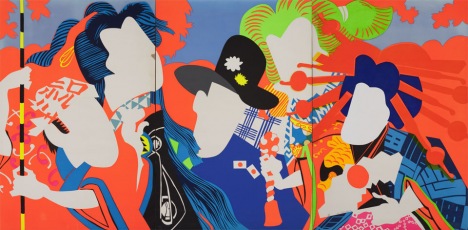In today’s Arts & Leisure section of The New York Times, Â the Walker Art Center’s new International Pop exhibit gets a good curtain-raiser. Randy Kennedy makes its case “not only that Pop was sprouting in countless homegrown versions around the world but also that the term itself has become too narrow to encompass the revolution in thinking it represented for a generation of artists.” Pop was not, in other words, just an American invention with “a British offshoot.”
 And this is the year, it seems, for that subject–the article also mentions the Tate’s upcoming exhibit, The World Goes Pop, which opens in September. Self-described by the museum, it is:
And this is the year, it seems, for that subject–the article also mentions the Tate’s upcoming exhibit, The World Goes Pop, which opens in September. Self-described by the museum, it is:
a groundbreaking exhibition revealing how artists around the world engaged with the spirit of Pop, from Latin America to Asia, and from Europe to the Middle East. At Tate Modern from17 September 2015, the show will explode the traditional story of Pop art and show how different cultures contributed, re-thought and responded to the movement. Around 200 works from the 1960s and 1970s will be brought together, including many which have never been exhibited in the UKÂ before.
Someone, I hope, will review them both–as they were curated separately–to see the differences in, well, taste, and storyline. They share some artists, surely, such as Ushio Shinohara, whose Doll Festival is shown above, from the Tate show. You can see an excellent slide show drawn from the Walker’s view on the Times site.
Let me add one more “international” Pop exhibition that, in fact, began last November and closed in February. Â (Because of its premise, I had it in mind to mention it here months ago, but let it slip.) Schirn Kunstalle Frankfurt presented German Pop, billed as:
In Great Britain and the United States, the 1960s brought forth a cultural movement that would have an impact worldwide [and] … universal claim to popularity…Artists such as Christa Dichgans, Sigmar Polke, Manfred Kuttner, Konrad Klapheck, and Peter Roehr developed a specifically West German version of Pop Art that went beyond mere “coca-colonization.†They examined the banalities of everyday life in Germany, ironizing its narrow-minded tastes and typically German “gemütlichkeit.†As a kind of archeological investigation of the 1960s and early 1970s, the exhibition at the SCHIRN will take a closer look at the artistic activities that constituted “German Pop.†Broadening the focus to encompass far more than just the chief protagonists, it will surprise the visitors with many a new (re-)discovery. The Pop principle will here be revisited with an eye to the new realistic art production situated in a realm between entertainment and mass culture, and light will be shed on West German Pop as an expression of dissociation from a no-longer-unencumbered middle-class aesthetic.
The Frankfurt show also shares some artists with the Walker’s, such as Thomas Bayrle, and probably with the Tate’s too, though I don’t have a checklist.
So pop is in the air at museums, and also avidly desired by collectors these days. One wonders which game first.
Photo Credit: Courtesy of the Tate
